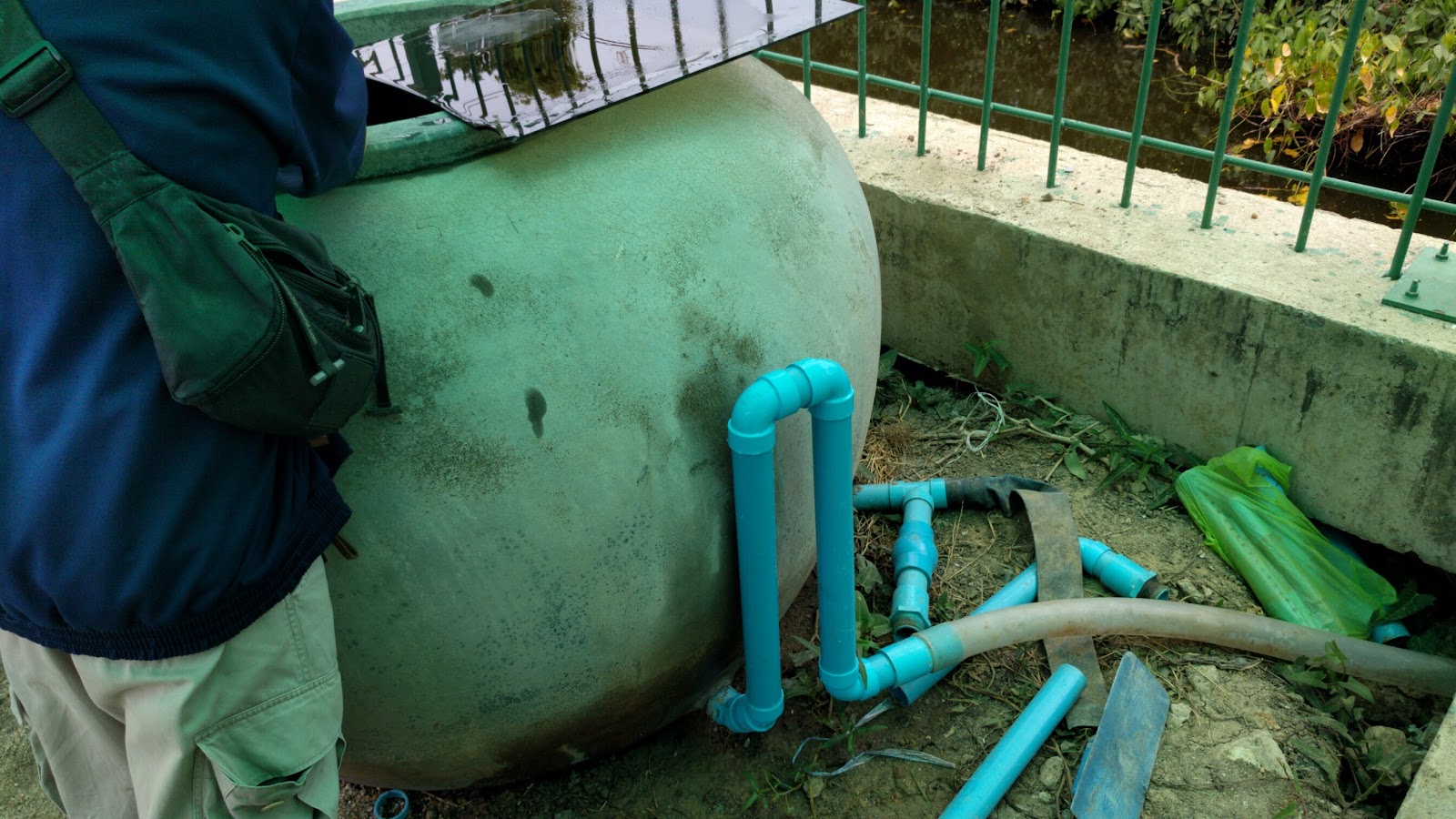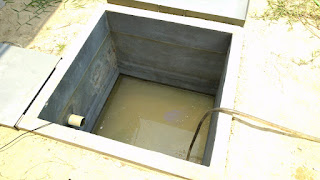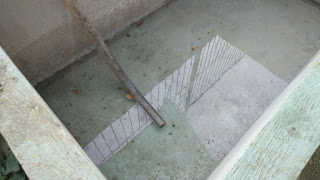Having recently built a slow sand filter, I was quite excited to test it yesterday for the first time.
WARNING: if you don’t want to read about what happens to the sewage in our house after the toilet is flushed, you should probably skip this post. 🙂
Our sewage system in BaanMae takes the black water sewage from the toilet and flushes it into an aerobic treatment system which aerates the sewage and breaks down the organic matter until it is discharged as a murky liquid effluent. The aeration causes it to break down significantly more than the anaerobic process in a typical septic system. This results in the effluent having a slightly unpleasant musty smell rather than the overwhelmingly unpleasant sewage smell of a septic tank.
But the effluent is definitely not something I would want to use untreated to water food crops. Here is a picture of our combined ATS treated effluent and greywater tank:
The greywater from sinks and showers is much cleaner than toilet water, but still contains small amounts of faecal matter such as washing your hands after going to the bathroom or from washing your hands after cleaning the cat poop tray or even trace amounts from the water runoff of taking a shower.
So I figured that while greywater probably doesn’t need the extra processing of an ATS (and the ATS will work more effectively if less greywater was added), it still makes some sense to process the greywater together with the output of the ATS.
So one of the uses I’ve been interested in the slow sand filtration for is as a second stage sewage treatment process. As mentioned previously, studies of properly functioning slow sand filters show E. coli and other pathogen removal rates can be as high as 98%. (See here and here.)
So for this test, I dropped a large aquarium pump into the effluent holding cistern and pumped it to the newly built slow sand filter (pump outlet pipe can be seen in the right side of the above picture).
Here is the hose going into the sand filter:
There needs to be some kind of diffuser to prevent the hose outlet from disturbing the surface of the filter much. We played with running the hose into a 1.5L water bottle with holes drilled in it, but I am planning on building something more permanent (and bigger).
The top of the slow sand filter is a murky black from having a 10-15cm layer of burnt rice ash which is actually about as fine as the finest sand and is supposed to be highly effective as the top layer in a slow sand filter:
After filtering down through the layer of very fine rice husk ash, fine filtered sand, course sand, small pebbles, and larger gravel, the water enters holes in a PVC pipe at the bottom, and leaves the sand filter:
It then climbs up the PVC pipe before dropping back down and flowing over to a cistern for holding the filtered water. The reason for this climb is to reduce the water pressure on the surface of the sand filter to help the biological filtration layer (schmutzdecke) form and to make sure that the water level never drops below the surface of the schmutzdecke which would cause it to dry out and die.
One of the most important points I’ve noticed in my reading is that the sand in the sand filter isn’t the primary filter. It is just a medium on which to grow the schmutzdecke. According to Wikipedia, a schmutzdecke will vary from surface to surface, but “will typically consist of a gelatinous biofilm matrix of bacteria, fungi, protozoa, rotifera and a range of aquatic insect larvae”. I think this is pretty cool. Much more interesting than the chlorine tablets that are often used on ATS effluent to process it for agricultural uses. (Although I haven’t ruled this option out, either.)
This schmutzdecke takes time to grow (up to a few months, I believe), so the quality of filtration I should see should greatly increase over the next few weeks or months. With that said, I was pretty surprised to see that the water that came out of the sand filter was perfectly clear and had absolutely no smell at all:
One possible explanation of this is that the amount of effluent I pumped through wasn’t enough to wash out all of the water that we had in the urn to begin with. But we pumped several hundred liters of effluent through the sand filter, and with all of the sand and rocks and gravel, I wouldn’t have thought there was that much water inside before. According to this page, a cubic meter of wet sand is only about 300kg heavier than a cubic meter of dry sand, so a cubic meter of wet sand should contain about 30% water. A quick rough calculation assuming that 30% of the volume of the sand filter is taken up by water (the rest being the sand and rocks) suggests there should have been at most about 90L of water in there. The water in this cistern is about 2m x 1m x 0.1m deep, meaning about 200L of displaced water. But since this is a rough calculation (not all of the sand filter is sand, there is also pebbles and rocks), maybe I am making some false assumptions. But it is still reasonably likely that at least half of the water than came out of the sand filter was from the effluent cistern.
So I will keep pumping effluent through the sand filter over the next week or two and see if the output water quality stays as clean as it looks now. If it does begin to degrade, I can just pump it back into the sand filter and keep cycling it back through until the schmutzdecke grows and begins to consume the nutrients and pathogens in the effluent and I truly have a fully functioning slow sand filter.
Once I get a healthy schmutzdecke grown, I am planning on submitting samples of the effluent and sand filter output water to a professional water testing lab to actually measure how clean is this output water compared to established standards for watering crops, etc.
Depending on the results of the water quality test, possible uses of this water includes (in order of how clean it would need to be):
- pumping up to sprinklers on the roof to spray the roof during the hot part of the day in order to cool down the house
- watering decorative plants (not for food)
- watering edible plants (for food)
 Having recently
Having recently 



